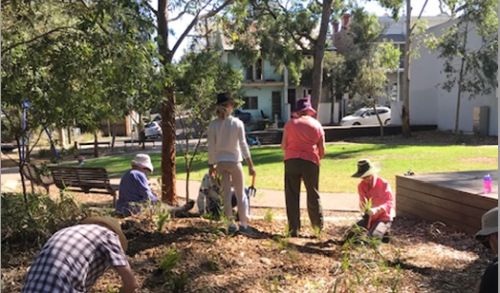Planting day in Orphan School Creek
On Saturday 14 April an enthusiastic group of 17 local residents donned gardening gloves and took up their trowels to help plant over 250 native tube stock at Orphan School Creek Reserve in Forest Lodge. The aim of the planting was to help increase the diversity and density of shrubs and grasses in the Reserve and encourage the return of native insects, reptiles and other wildlife. As usual, morning tea was a highlight of the morning.
A full house at local wildlife seminar
Dr John Martin, Wildlife Ecologist from the Royal Botanic Gardens, informed and entertained 55 members and their friends during a seminar on ‘Wild Sydney: living with animals’ at Benledi on 16 April 2018. This was the fourth seminar arranged by the Blue Wren subcommittee about urban biodiversity and we thank the executors of the Estate of the late Jan Craney, Roberta Johnston and Mary Holt for their financial support.
Comparative aerial photographs clearly show the greening of Glebe since the 1970s as residents and the local authorities have planted amazing numbers of native species in gardens, streets and parks. These plantings provide an important new food source particularly for larger wildlife species like flying foxes, Australian White Ibis and Sulphur-Crested Cockatoos.
Tagging of various species of flying foxes with small radio transmitters has shown that they can fly long distances along the east coast, from Bundaberg in the north to Melbourne in the south, in search of their favourite native foods. Food sources include nectar and pollen from flowering eucalypts such as Spotted Gums, especially down the south coast, but also fruit and the figs which thrive in Glebe’s parks, Arcadia Rd, and in other Glebe streets. On their journeys they stop off at colony sites (John called them ‘motels’) of which there are 15 in the Sydney region.
Flying foxes are particularly sensitive to the higher temperatures related to global warming. Temperatures of 43 degrees Celsius and above lead to heat stress and 45,000 deaths were recently recorded in a single colony during a heat wave.
Tagging of ibis has shown that they can also fly long distances in search of food. They are messengers of the plight of the Murray Darling Basin where the use of water by local towns and for irrigation (sometimes illegally) and drainage of the associated wetlands has removed their normal habitat and resulted in their migration to Sydney. Some of the ibis have settled permanently in Sydney as there is plenty of their natural food in our city’s parks and, of course, they love the left-over human food in our rubbish bins and garbage landfills.
The number of cockatoos in Sydney has also increased which is again related to enhanced native food sources in the City’s parks. However, they are probably not breeding every year due to the lack of nesting ‘hollows’ in large eucalypts. Such hollows can take a century to develop and cockatoos have appeared reluctant to use artificially created nesting hollows in younger trees.
Dr Martin also told us how a Wingtags project is helping to find out how cockatoos, ibis and brush turkeys are adapting to living in the city. Wing-tagging helps assess the behaviour of both populations and individuals, as well as their site-loyalty, population size and foraging, roosting and breeding habitat preferences. Go to the Wingtags website (https://www.rbgsyd.nsw.gov.au/science/the-wingtags-project) to see where birds have been sighted to date. There’s also an option to sponsor and name your own tagged bird.
Afterwards we enjoyed a glass of wine and Japanese finger food (generously donated by a member of the Blue Wren subcommittee) and inspected a beautiful range of ‘blue wren’ gifts displayed by Aviva Lacey from Natural Perspectives.









There are no comments yet. Please leave yours.